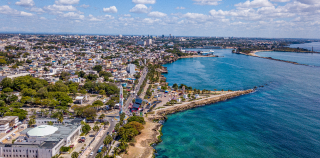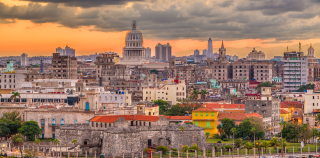- The average cost of travel insurance for US travelers is $307 per trip – based on travel insurance sales data for the past 12 months (Jan 2023 – Jan 2024).
- Data from Squaremouth shows that between April 2022 and January 2024, the average cost of travel insurance for US travelers was 4.60% of their total trip cost – below the industry standard of 5% - 6%.
- From 2022 to 2024, US travelers had an average trip cost of $6,343 as prices rise due to inflation.
- The final cost of travel insurance for your trip will depend on specific factors such as the total trip cost, destination, type of plan, and more.
- Aim to spend 6% of your total trip cost or less when buying travel insurance to ensure you are getting a fair deal. Anything less than this is considered a great deal.
- Using a travel insurance comparison tool is the best way to find the lowest prices on travel insurance policies.
How Much is Travel Insurance? | Average Cost In 2024
Understanding the average cost of travel insurance is key for identifying how much travel insurance could cost you.
To help you choose the best travel insurance for you needs, we analyzed policies from 31 different providers, including companies like AXA Assistance USA, IMG, John Hancock Insurance Agency, and Seven Corners, to discover the average amount people spent on travel insurance polices over the last year.
As of 2024, travel insurance plans typically cost about 5% to 6% of the total cost of your trip. This has always been a known figure in the travel industry, and our review of travel insurance quotes from top providers in the industry corroborates this figure for 2024.
The data shows that, for trips costing between $1k - $50k, travel insurance premiums can range from as low as $60 to $2,756, respectively.
Ultimately, how much you end up paying for travel insurance depends on the specific details if your trip, and many of the factors that determine the cost of travel insurance are within your control.
For example, the following are all influencing factors that can be adjusted to help reduce the cost of your travel insurance:
- the trip destination
- the length of your trip
- the total trip cost
- the types of coverage you choose
In this guide, we’ll show you how much travel insurance costs and how to get a free insurance cost estimate for your trip using our website. To start, here is an in-depth look at the average cost of travel insurance and how the price has fluctuated over the past year.
What’s the average cost of travel insurance in 2024?
The average cost of travel insurance for US travelers is around $307. This is based on a study of insurance sales data from 31 travel insurance providers over 12 months (January 2023 - January 2024).
There has been a progressive increase in travel spending over the last year, and the average cost of trips for US travelers increased roughly 21% from $5,988 in January 2023 to $7,427 in January 2024.
On average, travel insurance is around 5%-6% of the total trip cost, and the average trip cost for US travelers from April 2022- January 2024 was around $6,343.
As prices in
Below is a graph showing the changes in the average cost of travel insurance over the last year as well as the average price US travelers paid for their trips.
Average Cost of Travel Insurance by Month (2022 - 2024)
As seen in the chart above, the average travel insurance price has also gone up over the last year and a half – rising from $236 per trip in April 2022 to $303 per trip in January 2024.
That said, the cost of travel insurance varies between travel insurance providers. Therefore, it pays to compare plans from multiple providers before opting for a specific plan. The tool (below) is a good place to start.
Our top picks for travel insurance
Seven Corners
Generali Global Assistance
Tin Leg
Factors that impact the cost of travel insurance
As we’ve seen above, prices fluctuate depending on your trip details and how much coverage you want.
Trip cost
Travel insurance typically reimburses you for the total cost of your trip. As a result, this is one of the main factors that decide how much travel insurance costs. The reality is, more expensive trips require travel insurance premiums on the higher end, whereas budget-friendly vacations are typically much less expensive to insure. As an added example, some travel insurance plans like trip cancellation and trip interruption insurance can reimburse you for anywhere from 100% to 150% of your total trip costs. In these cases, it only makes sense that the cost of the insurance plan is higher.
Trip length
The length of your trip impacts travel insurance costs since you need coverage for more days. Also, the longer the trip the higher the possibility of something going wrong. This means that the insurance company must assume a greater risk. You’ll typically pay a lot more for a trip in Spain that lasts two weeks, for example versus just one week. Likewise, you’ll typically pay higher premiums for multi-trip or annual travel insurance plans versus one-off plans.
Age of traveler
The age of the traveler is an important factor in determining travel insurance costs. Senior travelers have an increased probability of falling ill or injuring themselves which means more medical expenses, which makes purchasing senior travel insurance crucial. In light of this, some travel insurance companies have an age limit to their policies.
Amount of travelers
Insuring a family or a large group inevitably costs more than insuring a solo trip. After all, more travelers in your group means there are more opportunities for things to go wrong which can lead to a higher payout from the insurance company. Despite this, some travel insurance providers, such as Travelex, offer free coverage for children ages 17 and under who are on the same plan as their parents or grandparents.
Type of plan
The type of travel insurance plan you buy can also affect the overall cost. For example, opting for a comprehensive travel insurance plan is more expensive than opting for medical coverage only or a cruise travel insurance plan specifically designed to cover potential risks on a cruise. You typically won’t get perks like baggage insurance, coverage for travel delays, or trip cancellation insurance when you forgo a comprehensive plan, but it can reduce the overall cost of your travel insurance policy. Therefore it’s important to consider what types of coverage you deem essential for your trip.
Coverage limits
Every travel insurance policy comes with a limit to how much the company will pay when you make a claim. The lower the limit, the less the plan will cost. A good example of this is travel medical insurance and medical evacuation insurance which usually make up the bulk of your travel insurance cost. These types of coverage typically have higher payout limits than other categories such as baggage insurance. Opting for less coverage will lower your overall cost, but that doesn’t mean it’s a good idea. When opting for cheap travel insurance we always recommend maintaining robust coverage limits.
Pre-existing conditions
Pre-existing conditions aren’t usually covered by travel insurance plans, but if they are, the policy tends to cost more than a standard policy. If you want coverage for pre-existing conditions you typically have to purchase a waiver for an extra fee ‘X’ days after making your initial trip deposit. (The amount of days depends on the company.) In the eyes of insurance companies, those with pre-existing conditions are more likely to need medical assistance while abroad. Therefore, plans that cover pre-existing conditions are usually more expensive.
Deductible amount
A deductible is the amount of money you must pay toward a claim before the insurance will start to pay out. Some travel insurance plans have a deductible, but this is always the case. Opting for a higher deductible can lead to a lower overall cost, whereas choosing a lower deductible or no deductible means paying more. Always read the fine print to ensure there are no surprise charges.
Add-ons & additional coverage
Travel insurance policies offer all kinds of add-ons that can cause the cost of coverage to skyrocket. Some of the most popular add-on coverages include cancel for any reason travel insurance (CFAR), interruption for any reason (IFAR) coverage, rental car coverage, insurance for sports equipment, and coverage for pre-existing medical conditions. Just one of these could increase your travel insurance policy by around 50%, so beware of add-ons if you are trying to keep costs down.
Examples of cost fluctuations based on trip details
To help you understand these concepts better, we worked through some real-world examples and compared a range of travel insurance quotes for various trips, ages, and types of plans.
Then, we found the average cost of travel insurance based on the following variables:
- Total trip cost
- Age of the travelers
- Type of coverage
- Add-ons
1. Average cost of travel insurance by trip cost
Using the LA Times Compare tool, we got quotes for a seven-night trip with costs ranging from $1,000 to $50,000.
The chart below shows how much the average trip cost for one person (age 35) impacted premiums in 2023:
| Average Trip Cost (Single Traveler) | Average Travel Insurance Premium | Percentage of Trip Cost |
|---|---|---|
| $1,000 | $60.05 | 6% |
| $2,500 | $118.51 | 5% |
| $5,000 | $220.07 | 5% |
| $10,000 | $487.25 | 5% |
| $20,000 | $1,067.20 | 5% |
| $30,000 | $1,750.89 | 6% |
| $40,000 | $2,269.44 | 6% |
| $50,000 | $2,756.73 | 6% |
We received travel insurance quotes for all the top providers to prepare this analysis, and we weren’t surprised to find that more expensive trips required higher travel insurance costs overall.
As you can see from the chart above, the cost of a vacation will greatly impact the premiums each insurance company charges. Still, we found that average travel insurance costs for all trips worked out to approximately 5% to 6% of the trip cost, on average.
2. Average cost of travel insurance by age
To give you an idea of the average cost of travel insurance as it pertains to age, we compared plans for a seven-night trip costing $2,500 for one traveler.
We got quotes using the LA Times Compare tool for the same trip parameters, only altering the age of the traveler from 20, 30, 40, 50, 60, 65, and 75.
The chart below provides an overview of the average cost of travel insurance by the age of the traveler:
| Traveler Age | Average Travel Insurance Premium ($2,500 Trip) | Percentage of Trip Cost |
|---|---|---|
| 20 | $94.20 | 4% |
| 30 | $95.53 | 4% |
| 40 | $123.32 | 5% |
| 50 | $134.44 | 5% |
| 60 | $177.01 | 7% |
| 65 | $191.30 | 8% |
| 75 | $308.10 | 12% |
As you can see from the study above, the travel insurance premium for a $2,500 trip ranges from 4% of the trip cost for travelers ages 20 to 30 up to 8% of the trip cost for a 65-year-old and 12% of the total trip cost for a 75-year-old. Therefore, it’s safe to say that age matters to travel insurance providers, although this is more true for people 60 years old or older.
Travel insurance companies price premiums based on the level of risk they’re taking for each covered trip, and it’s not surprising that it’s riskier to insure older travelers who are more likely to experience a medical event.
3. Average cost of travel insurance by type of coverage
While it’s difficult to answer how much is travel insurance, across different providers with different coverage options and limits, we got quotes for different plans from several top providers to give you an idea.
The chart below shows how much you would pay for travel insurance that covers a seven-night vacation for a total cost of $3,000 if you went with a budget plan, mid-tier coverage, or premium travel insurance:
| Travel Insurance Company | Budget Plan | Mid-Tier Coverage | Premium Coverage |
|---|---|---|---|
| AXA Assistance USA | $107 | $127 | $177.27 |
| Battleface | $51.68 | $73.08 | $138.52 |
| Generali Global Assistance | $101.25 | $117.45 | $135 |
| HTH Worldwide | $101.81 | $122.75 | $165.32 |
| IMG | $87.77 | $100.43 | $183.06 |
| John Hancock Insurance Agency | $132 | $140 | $185 |
| Nationwide | $97.42 | $122 | $140 |
| Tin Leg | $92.69 | $169 | $203 |
| Trawick International | $90.35 | $124.58 | $126.70 |
Based on this study, it’s clear to see that the type of insurance policy you choose impacts the total cost, whether you opt for budget travel insurance, a middle-tier plan, or comprehensive coverage with exceptional limits.
4. Average cost of travel insurance with add-ons
As we mentioned earlier, add-ons can significantly increase the cost of travel insurance policies.
To give you a concrete example of this, we chose to study the cost of travel insurance plans with cancel for any reason insurance (CFAR) added to the policy.
Cancel for any reason travel insurance that lets you cancel a trip and be reimbursed for 50% to 80% of your prepaid trip expenses. This coverage can be used for any reason at all, even if you simply change your mind and decide to stay home.
The chart below shows how much two adult travelers would pay for some travel insurance plans for a seven-night trip with a total cost of $5,000.
| Travel Insurance Plan | Cost without CFAR | Premiums with CFAR Coverage Included | Percentage of Increase with CFAR Coverage |
|---|---|---|---|
| Berkshire Hathaway Travel Protection LuxuryCare | $444 | $609.96 | 38% |
| HTH Worldwide TripProtector Preferred | $275.01 | $412.52 | 50% |
| John Hancock Insurance Agency Silver | $236 | $354 | 50% |
| Nationwide Cruise Luxury | $248 | $372 | 50% |
| Seven Corners RoundTrip Choice | $326 | $462.92 | 45% |
| Tin Leg Gold | $274 | $411 | 50% |
| Travelex Travel Select | $316 | $442.40 | 40% |
| Trawick International Safe Travels Voyager | $207.62 | $352.94 | 65% |
| USA Affinity Ruby | $280 | $420 | 50% |
While having CFAR coverage can be beneficial for travelers who are not entirely sure of their trip plans, this optional add-on can cause travel insurance premiums to increase by anywhere from 38% to 65%. Ultimately, we found that the average cost of adding CFAR to a policy equals approximately 48.6% of the premium.
How much should I spend on travel insurance?
You should aim to spend 6% or less of the total cost of your trip when searching for travel insurance. Anything less than 5% is considered a great price.
As an example, this means that travel insurance for a $5,000 vacation should cost between $250 and $300 – approximately.
If we follow this same rule, the cost of travel insurance for a $2,500 trip should be between $125 and $150, and premiums for a $15,000 trip should cost you between $750 and $900.
While these numbers are based on industry standards and internal research, our research did find some exceptions to this rule.
For example, travel insurance premiums tend to increase for:
- Older travelers
- Plans with higher coverage limits
- Plans that cover more than one traveler
People over the age of 60 can expect to pay the most. Plans that cover more than one traveler also cost more in general, as do travel insurance plans with higher coverage limits.
If you are hoping to get the best deal on travel insurance, you should take the time to compare at least three or four travel insurance plans side-by-side. Not only should you compare plans based on the types of coverage offered and the policy limits, but you’ll want to look at your out-of-pocket expenses, too.
From there, you’ll want to make sure your plan covers every conceivable issue you may run into, from missed connections to the contraction of COVID-19. With some research and planning, you can purchase coverage that puts travel-related issues aside so you can enjoy a worry-free trip.
You can get a free quote using our tool below. Simply enter your dates and destination to get a customized quote.
FAQ: cost of travel insurance
What is the approximate cost of travel insurance?
Travel insurance costs approximately 5% to 6% of the total cost of your trip. Based on travel insurance sales data from 31 different providers over the past year (from April 9, 2022 – April 9, 2023), the average cost of travel insurance for US travelers is $283 per trip. The average trip lasted 16 days and cost around $6,003.
Is it worth paying for travel insurance?
Travel insurance is worth it if you don’t have other types of insurance in place to cover the cost of incidents while traveling. The added expense of buying travel insurance can be well worth it if you run into a costly issue during your vacation. A lot of times, US health insurance does not work abroad. As an example, a conservative estimate for the cost of medical evacuation while traveling is around $25,000. However, this cost increases exponentially if you are overseas and need to be sent home, or are traveling in remote locations. Without travel insurance, you would be forced to pay for this cost out-of-pocket.
Who should get travel insurance?
Seniors, families, pregnant travelers, and those with pre-existing health conditions are prime examples of people who should buy travel insurance. However, there are some situations where travel insurance is essential for everyone. If you’re traveling overseas where your traditional health insurance coverage will not apply, even across the border in Canada, for example, travel insurance is the only way to ensure your medical expenses are covered.
Not only that, but trip insurance can reimburse you for non-refundable trip costs relating to hotels and flights you booked, missed connections, and medical expenses you rack up overseas. These costs can easily exceed the cost of travel insurance premiums, sometimes by tens of thousands of dollars. Keep in mind that flight insurance booked through an airline may not cover extra expenses such as medical complications.
Does travel insurance cover COVID-19 related issues?
Since COVID-19 has become commonplace, most travel insurance companies cover it the same as any other illness. This typically includes treatment or hospitalization from getting sick. Some travel insurance companies even cover doctor-ordered quarantine if you come down with COVID-19 during a covered trip and will cover the costs of extending your stay if you are forced to quarantine.
All travel insurance policies highlighted on our site include additionally COVID-19 travel insurance. If you are shopping elsewhere, make sure to read over the fine print before you select a plan as not all travel insurance policies offer this coverage.
Is travel insurance a one-time fee?
Some companies may offer options for paying in installments, but typically, travel insurance is a one-time fee that you pay upfront before going on your trip. Multi-trip travel insurance or annual travel insurance plans can cover more than one trip per year and may offer installment payments. However, most people buy a single travel insurance policy before each trip and a one-time fee.
What percentage of trip cost is travel insurance?
According to our research, travel insurance costs between 5% to 6% of the total trip cost for most travelers. All things considered, this is a small price to pay for peace of mind and being able to enjoy a worry-free trip.






























































